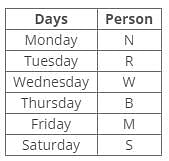BPSC TGT SST (History & Economics) Mock Test - 1 - Bihar PGT/TGT/PRT MCQ
30 Questions MCQ Test Bihar TGT Exam Mock Test Series 2024 - BPSC TGT SST (History & Economics) Mock Test - 1
Fill in the blanks with the correct preposition.
The cat always sleeps ____ my bed.
जाके पाँव म फटी विवाई वो क्या जाने पीर पराई
| 1 Crore+ students have signed up on EduRev. Have you? Download the App |
दिए गए शब्द युग्म का सही अर्थ ज्ञात कीजिए।
सर्व-शर्व
Directions: Study the following question carefully and choose the right answer.
If ACELDNRA stands for CALENDAR, what does LEGIBIEL stands for?
Direction: Read the given instructions carefully and answer the questions given beside.
Six people have midterm exam on different days of the same week, starting from Monday to Saturday. Who has exam immediately after B?
I. W has exam before B. N has exam before R. No one has exam after S. M has exam after Thursday. Three people has exam between S and R.
II. N has exam immediately after M. Two people have exam before R, who has exam immediately after S. B has exam after R but not on Saturday.
80 men can complete a work in 40 days and 50 women can complete the same work in 40 days. If the efficiency of each man is the same and the efficiency of each woman is also the same, the efficiency of each man is what percentage of the efficiency of each woman?
Jains celebrate five major events in the life of a Tirthankara. They are called Kalyanak (auspicious events). Consider the following regarding them.
1. Chyavana Kalyanak is the event when the Tirthankara's soul is born.
2. Diksha Kalyanak is the event when the Tirthankara's soul attains true knowledge.
3. Kevaljnana Kalyanak is when Tirthankara's soul leaves the physical existence and becomes a Siddha.
Select the correct answer using the codes below.
Consider the following statements:
- Statement I: The Mauryan Empire's economy was significantly advanced by the appointment of 27 superintendents to regulate various sectors, including agriculture, trade, and mining.
- Statement II: The economic regulations under the Maurya administration hindered the growth of private enterprise and led to the empire's economic stagnation.
Which one of the following is correct in respect of the above statements?
Which statement on Sangam history is incorrect?
The term Sudra is mentioned in the Rig Veda only once. How many times does the term ‘Vaisya’ appear in the Rig Veda?
The executive committee of which one of the following general assemblies was called alungnum?
Which of the following foreign authors say something about Sangam age?
I. Pliny, the Elder
II. Strabo
III. Author of the Periplus of the Erythrean sea
IV. Ptolemy
Consider the following statements.
1. The Muslim participation was nowhere in the civil disobedience movement because of appeals by Muslim leaders to stay away from the movement especially in NWFP
2. Traders' associations and commercial bodies opposed the movement
Which of these statements is/are correct?
Who was the Governor of Madras who concluded the Treaty of Mangalore with Tipu Sultan?
The founders of the Paramhansa Mandali believed in one God and were primarily interested in breaking caste rules. At its meetings, members took food cooked by low caste people. This mandali was founded in 1849 in
Banks use the major portion of the deposits to ______.
Assertion: Multinational companies help in the growth of local companies.
Reason: The activities of MNCs like research manufacturing, customer care services are spread over many countries.
Proportion of literate population in the 7 and above age group is called as:
On which of the following basis, the sectors are classified into public and private sector ?
What are public facilities, and why are they considered essential for a nation?
Hidden unemployment is also called
When was ISO certification established ?
Which of the following are examples of informal sector loans?
What is the Gini coefficient, and how is it related to income inequality?
Name the court to which a consumer can approach, having a claim of Rs. 40 lakhs
Recently there was a proposal to translocate some of the lions from their natural habitat
in Gujarat to which one of the following sites?
In response to India's 'Look East' policy, which of the following countries has launched 'Look West' policy? (Both are complementary to each other.)
Services constitutes________________ sector of an economy.

























